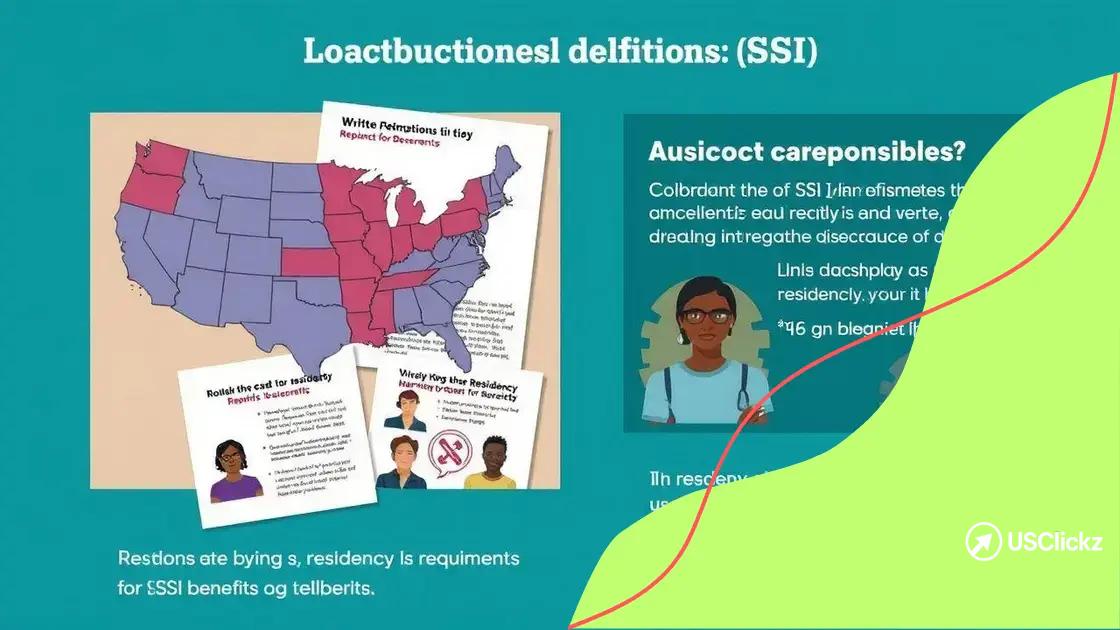SSI: Eligibility explained and how to qualify

Anúncios
To apply for SSI effectively, gather necessary documents, submit a complete application, meet deadlines, and avoid common mistakes such as not keeping copies of your submissions.
SSI: Eligibility explained can be a maze for many looking to find out if they qualify for essential benefits. Have you wondered if you meet the criteria? This guide aims to shed light on the process.
What is SSI and who qualifies?
SSI, or Supplemental Security Income, is a program designed to provide financial support to individuals with limited income and resources. Understanding who qualifies for this program can be essential for those in need of assistance.
Who qualifies for SSI?
Qualification for SSI is based on various factors, including age, disability, and financial status. Here are the main eligibility criteria:
- Must be at least 65 years old, blind, or disabled.
- Income must be below a specific limit set by the Social Security Administration (SSA).
- Resources must be limited, typically under $2,000 for individuals and $3,000 for couples.
- Must be a U.S. citizen or a qualified non-citizen.
If you meet these criteria, you may be eligible for SSI benefits. It’s crucial to gather documentation and provide accurate information during the application process. This can help prevent delays and complications.
How is SSI income calculated?
The SSA calculates income based on two main categories: earned income and unearned income. Earned income includes wages from jobs, while unearned income includes things like Social Security benefits and pensions. Knowing how these are assessed can influence your eligibility.
It’s helpful to understand that the SSA will consider your living situation too. For example, individuals living in the household of someone else may have different income calculations. Thus, it’s essential to review your situation thoroughly.
SSI is vital support for many. If you or someone you know believes they might qualify, taking the first steps to apply can lead to beneficial assistance.
Understanding income limits for SSI eligibility
To qualify for SSI, it is crucial to understand the income limits set by the Social Security Administration (SSA). These limits determine who can receive benefits and how much assistance one may get.
What are the income limits?
Income limits for SSI eligibility vary based on several factors, including living arrangements and family size. Generally, as of 2023, the income limit is $1,500 for couples and $1,000 for individuals.
- Countable income includes wages, pensions, and Social Security benefits.
- Some income, like certain gifts or loans, may not count.
- Different rules apply for people living alone versus those living with others.
Understanding the distinction between counted and non-counted income can significantly affect your eligibility. If you know your income exceeds these limits, it’s a good idea to explore possible deductions or exceptions.
Types of income considered
The SSA considers two main types of income: earned and unearned. Earned income comes from working, while unearned income includes funds from sources like interest and rental payments. It’s important to report all sources of income accurately when applying for SSI.
Knowing how these different income types affect your eligibility can help you make informed decisions. Sometimes, you may find ways to reduce your countable income, which may better your eligibility situation.
Always check the latest updates with the SSA to ensure your information is current. Rules may change, and being informed can help you navigate the SSI eligibility properly.
Residency requirements for SSI benefits

Residency requirements for SSI benefits are crucial for anyone looking to qualify for assistance. Understanding where you live and your citizenship status can significantly impact your eligibility.
Who can apply?
To qualify for SSI benefits, applicants must be U.S. citizens or meet specific non-citizen criteria. For example, lawful permanent residents and refugees can also be eligible. It’s essential to have documentation to prove your status when applying.
- U.S. citizens must provide proof of citizenship.
- Non-citizens must provide documents like green cards or refugee status verification.
- Recent immigrants may have a waiting period before becoming eligible for benefits.
Understanding these requirements is key. If you’re unsure of your status, it’s wise to gather your documents and consult with the SSA.
Residency definitions
Residency is defined as living in one state. You must reside in the U.S. or the Northern Mariana Islands, and you may have to live in the state from which you are applying for benefits. If you move, your eligibility can change.
Being physically present in the U.S. is a crucial part of the residency requirement. This requirement establishes that SSI is designed to support individuals who live within the U.S. and make it their home.
Sometimes, exceptions apply, such as students studying abroad. Always check with the SSA for specific rules that might apply to your situation.
How to apply for SSI effectively
Applying for SSI effectively can make a big difference in receiving benefits in a timely manner. Understanding the application process is key to ensuring that you meet all requirements.
Gather necessary documents
Before you apply, gather important documents. These documents will prove your identity, income, and residency. Here’s a list of what you’ll need:
- Proof of income, such as pay stubs or bank statements.
- Identification, like a driver’s license or social security card.
- Proof of residency, including utility bills or lease agreements.
- Medical records if applying based on disability.
Having organized documentation can speed up the process and reduce errors in your application.
Online vs. in-person applications
You can apply for SSI online or in person at your local Social Security office. Online applications are convenient and can be done at your own pace. For those who prefer face-to-face interaction, visiting an office allows for direct assistance. If you choose the online route, make sure to have all your documents ready.
Understanding the pros and cons of each method can help you choose the best approach for your situation. Take time to read through the instructions carefully on the SSA website if applying online.
Once your application is submitted, you can check its status online. This will help you stay informed about any additional information the SSA may need. Remember to respond quickly if they contact you.
Applying for SSI doesn’t have to be overwhelming. With thorough preparation and understanding of the process, you can approach your application with confidence.
Common mistakes to avoid when applying for SSI
When applying for SSI, avoiding common mistakes can significantly enhance your chances of getting approved. Understanding these pitfalls is essential for a successful application.
Incomplete applications
One of the most frequent mistakes is submitting an incomplete application. Ensure that all sections of the form are filled out properly. Double-check for missing information or signatures before submitting.
- Provide all requested documents.
- Verify that your contact information is accurate.
- List all sources of income, even if you think they may not count.
This attention to detail pays off and prevents unnecessary delays in processing your application.
Not keeping copies
Failing to keep copies of submitted forms and documents can lead to issues later on. If the SSA requests additional information, having your documents allows you to respond quickly.
It’s smart to create a personal file with all application materials. This way, you can track what you’ve submitted and follow up if needed.
Missing deadlines
Another critical mistake is overlooking deadlines. Applications can take time to process, so starting early is vital. Pay attention to any dates given by the SSA, including deadlines for responding to requests or providing additional documentation.
Missing a deadline can result in a rejected application or delays in receiving much-needed benefits. Set reminders to stay organized.
Applicants should be aware that the SSI process can be complex. Taking your time to understand the requirements and avoiding these common errors will make a significant difference in your experience.
FAQ – Common Questions About Applying for SSI Benefits
What documents do I need to apply for SSI?
You will need proof of income, identification, proof of residency, and medical records if applying based on disability.
Can I apply for SSI online?
Yes, you can apply for SSI online on the Social Security Administration’s website, or you can visit your local office.
What common mistakes should I avoid when applying?
Avoid submitting incomplete applications, not keeping copies of your documents, and missing deadlines.
How can I check the status of my SSI application?
You can check the status of your application online through the Social Security Administration’s website or by contacting your local office.